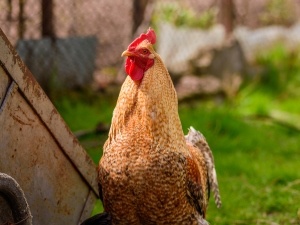
A healthy chicken beak is meant to be smooth, clean, and free from any growths or abnormalities, if you notice that your chicken has a growth on its beak you’d be right to be worried.
This article explores why there is a growth on your chicken’s beak.
Table of Contents
Growth on chicken beak:
A change in your bird’s appearance should make you at least a little bit curious, change can be a good or a bad thing. Below are possible reasons why your bird may have a growth on its beak.
Canker:
Canker doesn’t only affect humans, it can affect chickens as well. This infection is caused by the Trichomonas gallinae parasite.
Birds of all ages can develop canker but younger birds have a higher chance of developing canker. Canker is spread through drinking water and seed.
If wild birds, like pigeons, have access to the same drinking water that your chickens do then your chickens may develop canker.
A bird that is suffering from canker will develop a growth, that looks like yellow cheese, in its beak. This growth can start to overgrow and grow outside of the bird’s beak.
Other signs of canker in chickens include weight loss and vomiting. This disease can, if not treated, eventually cause the bird to have trouble eating, drinking, and breathing. Some birds who have this disease will show no signs of having the disease.
What to do:
Treatment options for canker in your chicken include a single dose of Carnidazole (Sparrtrix) and Metronidazole (Flagyl). These are prescription medications so you’d need to contact your vet to get a hold of them.
Ronidazole (Ronnivet-S) can also be used to treat canker in your birds. Give the bird this medication in its water, do this for seven days.
Abscess:
Abscesses can develop almost anywhere on a chicken’s body, including on the bird’s beak. If the bird develops a wound on its beak then bacteria can enter into the bird’s beak wound causing a bacterial infection that will turn into an abscess.
The wound on the bird’s beak may be caused by a splinter, or another foreign object, the bird’s body will try to isolate and contain this foreign object. The foreign object will likely have bacteria on it.
The bird’s body recognizes that there is a bacterial infection in the bird’s beak and the body sends white blood cells to fight the infection.
The white blood cells will attack the bacteria in the area but nearby tissue may also die as a result. A whole will form where the live tissue was and this hole will fill with pus forming an abscess.
What to do:
The abscess is likely quite painful but the bird is likely very hesitant to showcase that it is in pain.
Nevertheless, you can still help with the pain by using a warm wet rag against the abscess to relieve the bird of pain and help drain the abscess.
You’ll know that the draining is going successfully if the abscess is shrinking the more you add heat to it over some time.
You would need to offer supportive care to the bird while the body does the work of draining the abscess.
If draining the abscess is beyond the bird’s immune system then you may have to have the abscesses lanced and drained by a vet.
The vet will likely give the bird antibiotics to keep the area from becoming reinfected and to ensure that any leftover bacteria is killed off
The vet will also likely recommend probiotics for your bird to bring back the good bacteria that the antibiotics killed off along with the bad bacteria
An insect bite:
Insets can bite chickens and this can cause the birds to develop growths on their beaks. Insects that can bite chickens and cause growths to develop include bees, hornets, spiders, and wasps.
The bite will cause a gradual growth on the bird’s beak over some time. You likely won’t know that the bird has an insect bite until you see the bump, the bird won’t fuss about the bite because it does not want to show that it is in pain.
If the bird was bitten by an insect then you’ll likely see two distinct scabs on the bump but this isn’t always the case.
What to do:
Insect bites on your chicken will usually resolve themselves. Leaving the bird alone, but keeping an eye on its behavior and keeping an eye on the bump, is recommended.
If the bird isn’t showing signs of being in distress from the bite then you can let it be. If the bird starts to show signs of distress then you should take the bird to the vet.
If you enjoyed this article then you may also be interested in other chicken related articles. Here are some articles that you may be interested in: Mold In Chicken Coop, Chicken Has A Broken Leg At The Hip, Chicken Missing Its Top Beak, Chicken Beak Peeling, Baby Chick Not Moving

